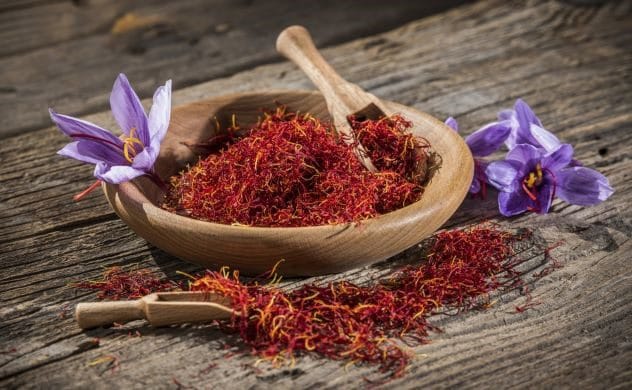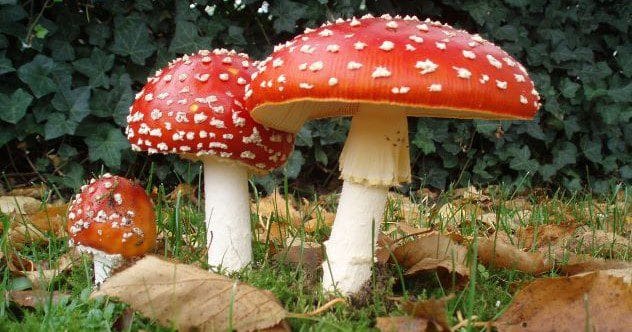It’s common to think of advanced drug knowledge as a modern thing, especially when we hear about substances like cocaine or heroin in turn-of-the-century “medicines.” This might make us assume that ancient societies knew even less about recreational drug use. Often, when we picture ancient parties like the Roman “Bacchanalia,” we mainly think of lots of wine.
However, it would be a mistake to believe ancient cultures only used alcohol to have a good time. History is filled with examples of recreational drug use, including substances that historians today aren’t even completely sure what they were. People in antiquity used everything from depressants and hallucinogens to things that were almost entirely poison, all to catch a bit of a buzz. Here’s a look at ten different drugs that were commonly enjoyed in ancient and classical history.
10. Saffron

Saffron, one of the world’s priciest spices, was also widely used in ancient medicine. Known scientifically as Crocus sativus, the stigmas from the crocus flower have been harvested since at least 3,000 BC. This valuable spice was used across many cultures. While Mesopotamian and Akkadian civilizations were among the first to use it, its role as a medicine, spice, and dye is documented from ancient Egypt to ancient Japan.
Ancient texts describe saffron as a potent painkiller and a mood-lifter for those with depression. Consuming more than five grams of the flower stigmas could produce opioid-like effects. For those who could afford this costly spice and used it regularly, it was even possible to develop a chemical dependency on saffron.
9. Kykeon
Kykeon, an ancient Greek beverage, is often described as a powerful hallucinogen. Unfortunately, its full recipe has been lost to time, though we know it contained wine, barley, and possibly honey. Mentions of this strong drink appear in Homer’s famous epics, The Iliad and The Odyssey. It also played a part in the secret rites of an Attican cult of Demeter, known as the Eleusinian Mysteries.
Some historians theorize that the parasitic fungus ergot might have been a key ingredient in kykeon. Ergot, a black fungus that grows on grains like rye and barley, is often too small to see. While ergot can cause hallucinations and altered states of consciousness, it’s also very harmful to muscles, causing more pain than pleasure. Safely refining ergot is a complex process, even today. It’s also one of the suspected culprits behind the Salem Witch Trials hysteria in 1692.
8. Fly Amanita
The fly amanita, with its iconic red cap and white spots, is well-known as both a potent hallucinogen and a fairly poisonous mushroom. Despite the risk of severe nausea and digestive problems, its recreational use is well-documented among people in historical Siberia and Scandinavia. Some even speculate it’s the mushroom behind “soma,” the famous intoxicating drink mentioned in the Vedic Texts of India.
Also known as Amanita muscaria or fly agaric, this vibrant fungus has been used for the last 4,000 years. The hallucinogenic effects come from chemicals like muscimol and ibotenic acid. Interestingly, these chemicals can pass through urine, making it possible for someone to experience the effects without the intense nausea—if they were daring enough to drink another person’s pee.
7. Blue Lotus
In Homer’s The Odyssey, Odysseus and his crew land on the mysterious Island of the Lotus Eaters, believed to be Djerba, near Tunisia. The islanders persuade Odysseus’s men to consume a blue flower, which leads to widespread laziness and a loss of desire to continue their journey. While many events in the poem are fictional, some believe that historical accounts of people consuming blue flowers for a high might have some truth to them.
The blue lotus, or Nymphaea caerulea, grows in North African countries along the Mediterranean. This flower contains apomorphine and nuciferine, chemicals that can cause euphoria and hallucinations. Although The Odyssey might reference it, the first historical mention of the blue lotus could be in the Egyptian “Book of the Dead,” an important religious text.
6. Mad Honey
Mad Honey comes from the Anatolian Peninsula, modern-day Turkey, but its use has also been recorded from ancient Greece to ancient Nepal. When bees pollinate the Anatolian Rhododendron luteum or Rhododendron ponticum, the resulting honey takes on a reddish color and loses its sweetness. This honey contains grayanotoxin from the flower, which produces noticeable hallucinatory effects when eaten.
Known as “Mad Honey,” this substance is a mixed blessing. While often used recreationally, consuming too much can lead to severe digestive issues, heart problems, and even paralysis. It was recorded in 69 BC that Pompey the Great’s armies were captivated by the local honey in the area. They subsequently fared poorly against Anatolian forces, partly due to the hallucinations and severe digestive troubles.
5. Ayahuasca
The ritualistic use of the hallucinogen ayahuasca is fascinating, especially because its cultivation, preparation, and consumption methods have remained consistent from around 900 BC to the present day. Although the first recorded use of ayahuasca was in Peru, the substance has spread throughout the Amazon Basin, including areas in modern-day Bolivia and Colombia.
Ayahuasca is a tea made from the Banisteriopsis caapi vine and leaves from the Psychotria viridis plant. It’s very rare for ayahuasca to be consumed outside its important ritualistic context. Unsurprisingly, the substance has attracted many curious visitors from Western countries wanting to legally try a hallucinogen, often without understanding its religious significance. This has led to a tourism industry that sometimes causes more harm than good.
4. Psilocybin
While fly amanita mushrooms are known for being poisonous, the famous “magic mushrooms” containing psilocybin are generally considered a more consequence-free hallucinogenic fungus. Like fly agaric, these brown-colored mushrooms have also seen widespread use throughout history. They are found naturally in Europe and the Americas, where they’re also known as “Liberty Caps” or, more poetically, “The Flesh of the Gods.” This latter name comes from their extensive use by priests and spiritual leaders in ancient religions.
Ancient statues and paintings depict people ingesting these mushrooms, either for spiritual purposes or recreationally. In Europe, one of the earliest depictions of psilocybin use dates back to around 4,000 BC, found on rock art near Villar del Humo. In Mesoamerica, images of liberty caps have been discovered from modern-day British Columbia down to Mexico.
3. Coca
The plant that gives us cocaine was used recreationally long before it was refined into a white powder. The leaves of the coca plant naturally contain the alkaloid that produces cocaine’s euphoric effect. This effect could be achieved simply by chewing the leaf or brewing it into a hot, tea-like drink. These traditional methods are thought to be less likely to cause a chemical overdose than the modern powdered form of cocaine.
The Incan Empire, located in the Andean Range of South America, cultivated the coca leaf as far back as 3,000 years ago. Coca consumption even spread north to civilizations in the Yucatan. Specifically, the Aymara people of the Andes, whose civilization in modern Bolivia may be over 5,000 years old, are credited with the origin of the word “Khoka.”
2. Cannabis
Cannabis, also commonly known as “weed,” specifically a sativa strain, was very popular in Roman circles during the Classical Period. Interestingly, it was used for much more than just recreational purposes. Some doctors at the time believed that consuming cannabis orally could repel mosquitos, treat venereal diseases, and even stop bleeding. However, the Romans also had a strong liking for getting high from pastries baked with cannabis, similar to modern edibles.
The ancient Greeks were also familiar with the cannabis plant, and it’s speculated that some wines were brewed with its leaves. The Mediterranean was far from the only place where weed was consumed; the plant was smoked and eaten in ancient civilizations across Africa, Europe, and Asia. It’s even thought that the first cultivation of hemp occurred as far back as 8,000 BC on the Oki Islands near Japan.
1. Opium
Certain strains of the poppy flower are rich in the alkaloid morphine. When the seed capsules of these flowers are properly refined, the psychoactive substance opium is created. This “Milk of the Poppy” has seen extensive use throughout history, though its first recorded use is more recent than that of marijuana. Around 3,400 BC, the Sumerian civilization was reportedly the first to cultivate the poppy plant for recreational drug use, though the later Assyrians perfected the refinement process.
Records of opium sales exist wherever trade with the Assyrians and Sumerians took place, and the substance became extremely popular in ancient Egypt and ancient Greece. Some classical scholars even suggest that Helen of Troy used the drug to ease the pain caused by the Trojan War. The poppy flower is also heavily associated with the twin Greek gods, Hypnos (sleep) and Thanatos (death), and the Egyptians linked the plant with Thoth, the god of knowledge, who was said to have gifted knowledge of the plant to humanity.
As we’ve seen, ancient cultures weren’t just limited to alcohol for altering their states of mind. From potent painkillers like saffron to powerful hallucinogens like kykeon and fly amanita, people throughout history have sought out and used a variety of psychoactive substances. The blue lotus offered euphoria, mad honey provided risky highs, and ayahuasca connected users to ancient rituals. Psilocybin mushrooms, coca leaves, cannabis, and opium all played significant roles, whether for recreation, medicine, or spiritual practices. These historical uses highlight a long and complex human relationship with mind-altering substances, showing that the desire for a “buzz” is far from a modern phenomenon.
What do you think about the recreational drug use in ancient times? Were you surprised by any of these? Leave your comment below!










